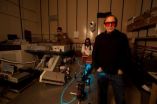(Press-News.org) Cystatin C, a blood marker of kidney function, proved significantly more accurate than the standard blood marker, creatinine, in predicting serious complications of kidney disease, in a study by researchers at the San Francisco VA Medical Center and the University of California, San Francisco.
Among adults who were identified as having chronic kidney disease by high creatinine levels, the researchers found that only patients who also had abnormally high levels of cystatin C were at high risk for death, cardiovascular disease, heart failure, or kidney failure. People with high creatinine but normal cystatin C levels had risks similar to those with normal creatinine levels.
The researchers also found that a "small but important segment" of the study population was missed by creatinine but identified by cystatin C as being at significant risk of serious complications, according to lead author Carmen A. Peralta, MD, MAS, an SFVAMC researcher and an assistant professor of medicine in residence in the division of nephrology at UCSF.
The study of 11,909 participants appears online on December 16, 2010, in the "JASN Express" section of the Journal of the American Society of Nephrology. The authors analyzed patient data from two prospective studies: the Multi-Ethnic Study of Atherosclerosis and the Cardiovascular Health Study, both sponsored by the National Heart, Lung, and Blood Institute.
Principal investigator Michael G. Shlipak, MD, MPH, chief of general internal medicine at SFVAMC, said that the current study highlights a potential clinical use for cystatin C as a method for confirming a diagnosis of chronic kidney disease. Shlipak has been a leader among physicians in identifying cystatin C as an alternative, accurate, and reliable marker of kidney function.
Both cystatin C and creatinine are substances made in the body and filtered by the kidneys. High levels of the substances in the blood indicate that the kidneys are losing the ability to filter them, and thus are losing function. "However," explained Peralta, "creatinine is a byproduct made in muscles, so it is affected by what you eat and especially by how much muscle you have." Thus, "a bodybuilder with healthy kidneys might have an elevated creatinine level because of high muscle mass, whereas a frail elderly person might have normal or even low levels of creatinine, but in fact this person's kidneys are not working well – it's just that there's not much creatinine because there's not much muscle."
In contrast, cystatin C is a protein made in cells throughout the body. "In studies so far, it does not seem to be that affected by age or muscle mass or diet," said Shlipak, who is also a professor in residence of medicine and epidemiology and biostatistics at UCSF.
Shlipak proposes that cystatin C, which can cost as little as $17 per test, be added as a method for confirming or staging chronic kidney disease in guidelines that are currently being formulated by nephrologists. "It's vital that we have an accurate diagnostic test, because kidney disease does not show symptoms until it's too late, when your kidneys have almost failed completely," he said.
"Being missed by creatinine is an important limitation in our current method of diagnosing kidney disease," said Peralta. Yet, she adds, being falsely identified with kidney disease through inaccurate test results can be disastrous as well. "There is fear and psychological stress, particularly in communities of color, where people have a lot of friends and family members who are on dialysis," she noted. "You can also be subjected to unnecessary and expensive tests and medications."
INFORMATION:
Co-authors of the study are Ronit Katz, DPhil, of the University of Washington; Mark J. Sarnak, MD, MS, of the Tufts-New England Medical Center; Joachim Ix, MD, of UC San Diego; Linda F. Fried, MD, MPH, of Pittsburgh Veterans Affairs Medical Center; Ian De Boer, MD, of UW; Walter Palmas, MD, of Columbia University; David Siscovick, MD, MPH, of UW; and Andrew S. Levey, MD, of Tufts-New England Medical Center.
The research was supported by funds from the National Heart, Lung, and Blood Institute, the National Institute of Neurological Disorders and Stroke, and the National Institutes of Diabetes Digestive and Kidney Diseases. Some of the funds were administered by the Northern California Institute for Research and Education.
NCIRE - The Veterans Health Research Institute - is the largest research institute associated with a VA medical center. Its mission is to improve the health and well-being of veterans and the general public by supporting a world-class biomedical research program conducted by the UCSF faculty at SFVAMC.
SFVAMC has the largest medical research program in the national VA system, with more than 200 research scientists, all of whom are faculty members at UCSF.
UCSF is a leading university dedicated to promoting health worldwide through advanced biomedical research, graduate-level education in the life sciences and health professions, and excellence in patient care.
New test can predict complications from kidney disease
2010-12-17
ELSE PRESS RELEASES FROM THIS DATE:
Immune cell plays unexpected role in autoimmune disease
2010-12-17
A new study provides fascinating insight into the underlying pathology associated with the autoimmune disease, systemic lupus erythematosus (SLE). The research, published by Cell Press in the December issue of the journal Immunity, reveals an unexpected role for a key type of immune cell and provides a potential new therapeutic strategy for SLE and, potentially, other autoimmune diseases.
SLE is a chronic systemic disease that can affect many regions of the body and, as a result, presents with diverse clinical symptoms. As is characteristic of other autoimmune disease, ...
Science's breakthrough of the year: The first quantum machine
2010-12-17
Until this year, all human-made objects have moved according to the laws of classical mechanics. Back in March, however, a group of researchers designed a gadget that moves in ways that can only be described by quantum mechanics—the set of rules that governs the behavior of tiny things like molecules, atoms, and subatomic particles. In recognition of the conceptual ground their experiment breaks, the ingenuity behind it and its many potential applications, Science has called this discovery the most significant scientific advance of 2010.
Physicists Andrew Cleland and ...
Computer memory takes a spin
2010-12-17
SALT LAKE CITY, Dec. 16, 2010 – University of Utah physicists stored information for 112 seconds in what may become the world's tiniest computer memory: magnetic "spins" in the centers or nuclei of atoms. Then the physicists retrieved and read the data electronically – a big step toward using the new kind of memory for both faster conventional and superfast "quantum" computers.
"The length of spin memory we observed is more than adequate to create memories for computers," says Christoph Boehme (pronounced Boo-meh), an associate professor ...
Why humans are more sensitive to certain viruses: Primate immune system differences identified
2010-12-17
The greater susceptibility of humans to certain infectious diseases when compared to other primates could be explained by species-specific changes in immune signaling pathways, a University of Chicago study finds. The first genome-wide, functional comparison of genes regulated by the innate immune system in three primate species discovers potential mediators of differences in disease susceptibility among primates. These findings are published on December 16 in the open-access journal PLoS Genetics.
Humans are more sensitive than chimpanzees to the severe effects of certain ...
Structural distortions emerge from nothing at the nanoscale
2010-12-17
December 16, 2010 - Scientists have discovered that a class of materials known to convert heat to electricity and vice versa behaves quite unexpectedly at the nanoscale in response to changes in temperature. The discovery - described in the December 17, 2010, issue of Science - is a new "opposite-direction" phase transition that helps explain the strong thermoelectric response of these materials. It may also help scientists identify other useful thermoelectrics, and could further their application in capturing energy lost as heat, for example, in automotive and factory ...
Using digitized books as 'cultural genome,' researchers unveil quantitative approach to humanities
2010-12-17
CAMBRIDGE, Mass. -- Researchers have created a powerful new approach to scholarship, using approximately 4 percent of all books ever published as a digital "fossil record" of human culture. By tracking the frequency with which words appear in books over time, scholars can now precisely quantify a wide variety of cultural and historical trends.
The four-year effort, led by Harvard University's Jean-Baptiste Michel and Erez Lieberman Aiden, is described this week in the journal Science.
The team, comprising researchers from Harvard, Google, Encyclopaedia Britannica, ...
Age doesn't matter: New genes are as essential as ancient ones
2010-12-17
New genes that have evolved in species as little as one million years ago – a virtual blink in evolutionary history – can be just as essential for life as ancient genes, startling new research has discovered.
Evolutionary biologists have long proposed that the genes most important to life are ancient and conserved, handed down from species to species as the "bread and butter" of biology. New genes that arise as species split off from their ancestors were thought to serve less critical roles – the "vinegar" that adds flavor to the core genes.
But when nearly 200 new ...
Light dawns on dark gamma-ray bursts
2010-12-17
Gamma-ray bursts (GRBs), fleeting events that last from less than a second to several minutes, are detected by orbiting observatories that can pick up their high energy radiation. Thirteen years ago, however, astronomers discovered a longer-lasting stream of less energetic radiation coming from these violent outbursts, which can last for weeks or even years after the initial explosion. Astronomers call this the burst's afterglow.
While all gamma-ray bursts [1] have afterglows that give off X-rays, only about half of them were found to give off visible light, with the ...
Most Medicare stroke patients rehospitalized or dead within year
2010-12-17
Nearly two-thirds of Medicare beneficiaries discharged from hospitals after ischemic stroke die or are readmitted within one year, researchers report in Stroke: Journal of the American Heart Association.
Stroke is the second leading cause of hospital admissions among older adults in the United States, according to American Heart Association/American Stroke Association statistics. Ischemic stroke, which occurs as a result of an obstruction within a blood vessel supplying blood to the brain, accounts for 87 percent of all strokes.
Only a few contemporary studies have ...
Most Medicare stroke patients die or are rehospitalized within year after discharge
2010-12-17
A UCLA-led has study found that after leaving the hospital, nearly two-thirds of Medicare beneficiaries hospitalized for acute ischemic stroke either died or were rehospitalized within a year.
The findings point to an opportunity for more quality-of-care initiatives to improve stroke care, especially in transitioning to home, stroke rehabilitation and outpatient care.
The study, which appears online Dec. 16 in Stroke, a journal of the American Heart Association, also found that hospital mortality and readmission rates varied widely nationwide, indicating there ...

